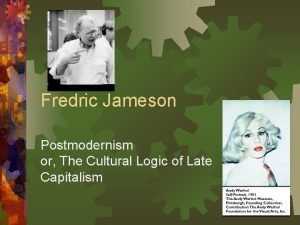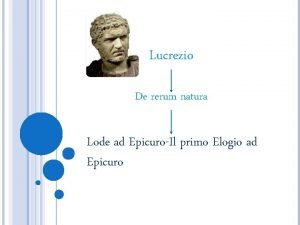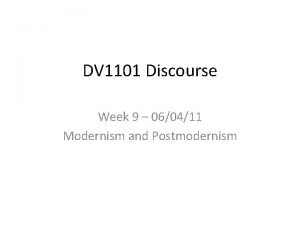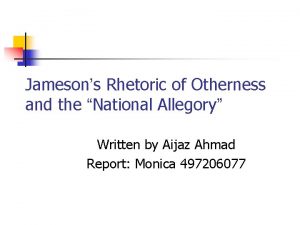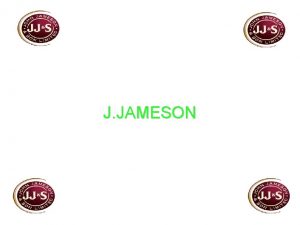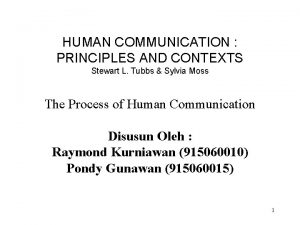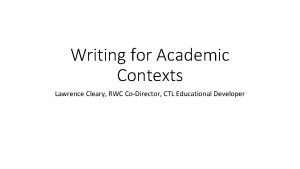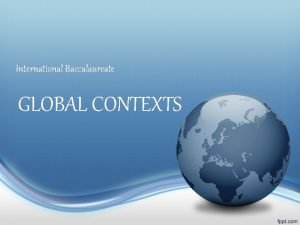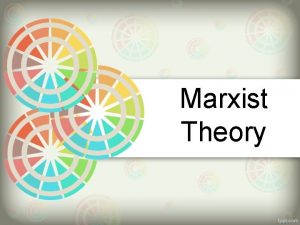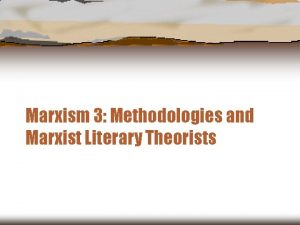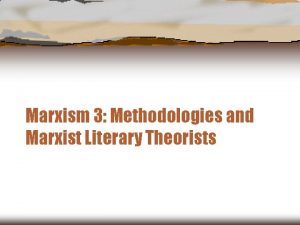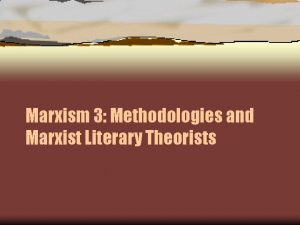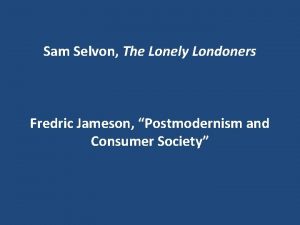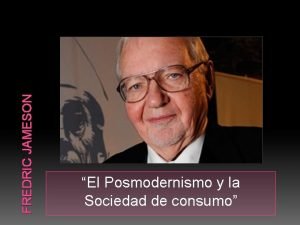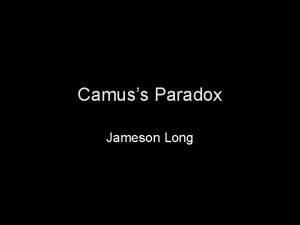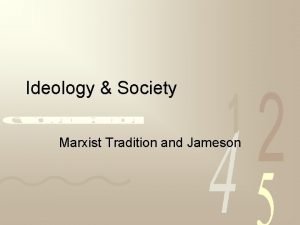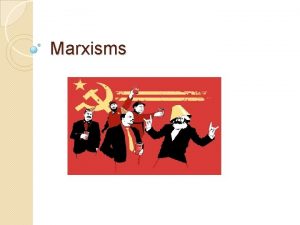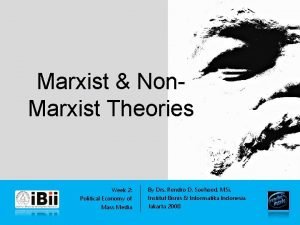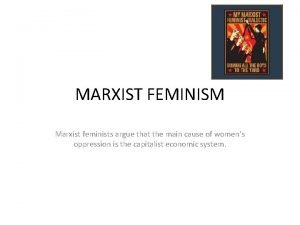Fredric Jameson Contexts Marxism Simulacra Shoes Marxism Marxist











![Late capital uses machines of reproduction, not production “The most energetic postmodern [work] seems Late capital uses machines of reproduction, not production “The most energetic postmodern [work] seems](https://slidetodoc.com/presentation_image_h2/4e82c6616a605d6e9f9a2513dd2de7e6/image-12.jpg)



- Slides: 15

Fredric Jameson: Contexts Marxism Simulacra Shoes!

Marxism! Marxist Dialectics: Base: the economic foundation of human society Superstructure: all other aspects of human society Vulgar Marxism/ Economic Determinism: the position that society is dialectic in these strict terms

Analytical Questions Does this class take a dialectic approach? Does Jameson?

Simulacra and Simulation Short philosophical text by Jean Baudrillard, 1985, uses postructuralist linguistics “The successive phases of the image: 1 It is the reflection of a basic reality 2 It masks and perverts a basic reality 3 It masks the absence of a basic reality 4 It bears no relation to any reality whatever: it is its own pure simulacrum” [a copy without an original] Examples: Disneyland, Watergate

Summary of Important Points I. The Deconstruction of Expression (shoes) II. Postmodernism and the Past (pastiche, historiography) III. Breakdown of Signifying Chain (intensities, euphorias) IV. Hysterical Sublime (stages of capital) V. Post-Modernism and the City (space) VI. Abolition of Critical Distance (leftist politics and representation)

The Deconstruction of Expression Peasant Shoes Diamond Dust

The Deconstruction of Expression • Modernism: Van Gogh’s shoes • Postmodernism: Warhol’s shoes: • “The Waning of Affect” (61): depthlessness, identity in image and not substance (62) • “The alienation of the subject is replaced by the fragmentation of the subject” (63)

The Postmodern and the Pastiche vs. Parody Pastiche is imitation (simulation) without judgment (good or bad) “Pastiche is thus blank parody, a statue with blind eyeballs…. Producers of culture have nowhere to turn but to the past: the imitation of dead styles, speech thrown through all the masks and voices stored up in the imaginary museum of a now global culture” (65).

History, Historicity, Historiography The “past” has lost its referent. We can only experience history as pastiche, as signs about the past that don’t contain meaningful content about history. “In faithful conformity to poststructuralist linguistic theory, the past as ‘referent’ finds itself gradually bracketed, and then effaced altogether, leaving us with nothing but texts” (66).

The Breakdown of the Signifying Chain “What I have been calling schizophrenic disjunction or écriture, when it becomes generalized as a cultural style, ceases to entertain a necessary relationship to the morbid content we associate with terms like schizophrenia, and becomes available now for more joyous intensities, for precisely that euphoria which we saw displacing the older affects of anxiety and alienation” (74).

“The Hysterical Sublime”: 3 Stages of Capitalism 1848: steam engines, market capitalism, realism 1890 s: electric and combustion engines, monopoly capitalism, modernism 1940 s-present: electronic (digital) and nuclear powered machines, “late”/ postindustrial/ multinational/ consumer capitalism, postmodernism
![Late capital uses machines of reproduction not production The most energetic postmodern work seems Late capital uses machines of reproduction, not production “The most energetic postmodern [work] seems](https://slidetodoc.com/presentation_image_h2/4e82c6616a605d6e9f9a2513dd2de7e6/image-12.jpg)
Late capital uses machines of reproduction, not production “The most energetic postmodern [work] seems to tap the networks of reproductive process and thereby to afford us some glimpse into a postmodern or technological sublime [77]” (79).

Post-Modernism and the City

A kind of summary (83) “This latest mutation in space— postmodern hyperspace—has finally succeeded in transcending the capacities of the individual human body to locate itself, to organize its immediate surroundings perceptually, and cognitively to map its position in a mappable external world. ”

An Abolition of Critical Distance “We cannot, however, return to aesthetic practices elaborated on the basis of historical situations and dilemmas which are no longer ours. Meanwhile, the conception of space that has been developed here suggests that a model of political culture appropriate to our own situation will necessarily have to raise spatial issues as its fundamental organizing concern. I will therefore provisionally define the aesthetic of such new (and hypothetical) cultural form as an aesthetic of cognitive mapping” (89).
 Pastiche postmodernism
Pastiche postmodernism Elogio di epicuro spiegazione
Elogio di epicuro spiegazione Unique forms of continuity in space
Unique forms of continuity in space Melanie jameson
Melanie jameson Kbt relationsproblem
Kbt relationsproblem Aijaz ahmad jameson's rhetoric of otherness summary
Aijaz ahmad jameson's rhetoric of otherness summary Jameson nicknames
Jameson nicknames The sociological perspective stresses that
The sociological perspective stresses that Human communication: principles and contexts
Human communication: principles and contexts Shape matching and object recognition using shape contexts
Shape matching and object recognition using shape contexts Writing in professional contexts
Writing in professional contexts The srs document is useful in various contexts:
The srs document is useful in various contexts: Bolongie
Bolongie Writing in academic contexts
Writing in academic contexts Scientific and technical innovation global context
Scientific and technical innovation global context Teachers in crisis contexts
Teachers in crisis contexts
